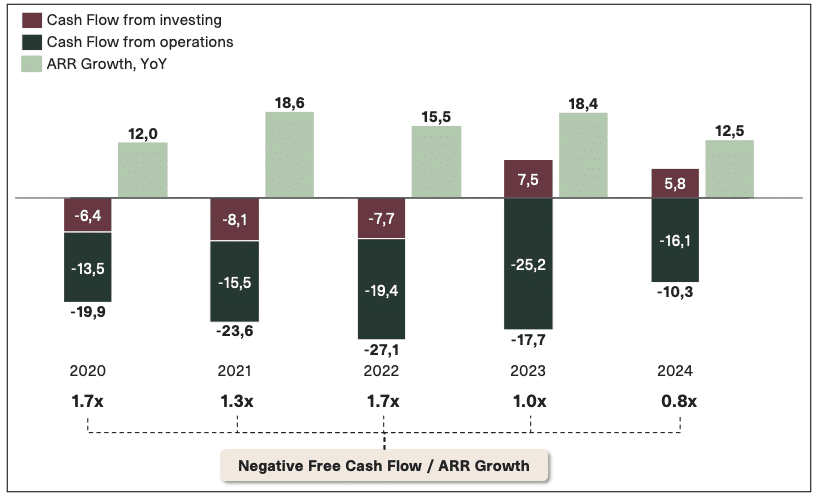
Burn rate in SaaS: How to calculate it and why investors care

Burn rate is not about losing money; it’s about how efficiently a SaaS company deploys the capital at their disposal to drive growth. In the early stages, almost all companies spend more than they earn, investing heavily in the product, go-to-market, and recruitment. Heavy investments like this are perfectly normal and expected. However, without control, burn rate can quickly become an issue if you run out of cash, and it forces you to raise funds at unfavourable terms.
As investors, we never look at burn rate in isolation, but always tie it to growth. We want to see good sales efficiency and a pathway to profitability. To maintain financial flexibility, we need to keep our burn rate under control.
Written by: Martin S. Eriksen, Senior Investment Manager at Viking Growth
What is burn rate?
Burn rate is the amount of cash a company spends net of revenue in any given month. If you spend 1.2 mEUR a year and generate new recurring revenues of 600 kEUR, your monthly gross burn is 100 kEUR, and your monthly net burn is 50 kEUR. This means you are spending 2 EUR to generate 1 EUR in new revenue, resulting in a burn multiple of 2x.
- Gross burn = total monthly operating expenses
- Net burn = expenses minus revenue (your true cash outflow)
- Burn multiple = how much cash you burn to generate 1 EUR of new ARR
A burn multiple below 1x is considered excellent. If you are spending 500 kEUR to add 1 mEUR in new ARR, you are highly efficient. A multiple of more than 3x is weak – you’re burning a lot of cash without converting it into durable growth. As an investor, we view companies with high burn multiples as risky investments. We want to see evidence over a longer time period showing that every euro invested creates new ARR.
Why founders misunderstand burn rate
In the early stages, many founders oversimplify things. Focusing only on their monthly gross burn or the number of months left before their bank balance hits zero, also known as their runway.
The problem with this approach is that it ignores the more nuanced measures of financial health, which is captured by net burn and the burn multiple. Investors use these metrics to assess whether the growth is efficient and sustainable, and not just how long a company can survive.
An oversimplified view of cash flow also overlooks certain distortions that occur throughout the year. Viking Growth is a big fan of annual upfront payments for subscriptions. A subscription model which allow companies to use their customers to finance growth. However, this approach will make your burn multiple look very low early in the year, but high later on. One-off payments, such as office moves or consultants, skew the picture as well, adding extraordinary expenses that are not part of normal operations. That’s why we normalize burn rate over a 6 – 12 month period.
Impact on growth and valuation
Burn rate is not a KPI we plug directly into our valuation models, but it does influence several of the KPIs included. Burn rate tells us how effectively a company converts capital into growth and thus impacts both risk and upside potential.
- High burn, with weak sales efficiency = high risk, low valuations
- High burn, with strong sales efficiency (40% YoY, solid CAC payback, high NRR) = attractive, investors are willing to pay up
An example from our own portfolio is Penneo. They deliberately invested heavily in growth to capture market share. Despite receiving criticism at IPO and while publicly listed for their aggressive spending, Penneo were rewarded because they could demonstrate both high growth and efficiency.
Example: Penneo

Notes:
2024 adjusted for the delayed tax credit of 5.5 mDKK and deferred employee taxes from 2023 of -2.4 mDKK
2023 adjusted for deferred employee taxes -2.4 mDKK
What do the numbers show?
- ARR growth: from 2023 to 2024, Penneo grew ARR by 12.5 mDKK
- Free cash flow: Over the same period, free cash flow was -10.3 mDKK (vs. -17.7 mDKK the prior year)
- Cash to ARR ratio: They spent 0.8 DKK in cash to generate 1 DKK in ARR
A cash to ARR ratio between 1.7 – 0.8x is efficient, especially when we consider the fact that each DKK of ARR delivers ~ 7 DKK in revenue over 5 years. Burning 1.7 – 0.8 to create 1 makes sense if the ARR is durable.
Why burn rate and efficiency matters?
- Efficient growth: A ratio of 1.7 – 0.8x is very good, showing an effective use of capital to build recurring revenues
- Investors’ lens: Negative free cash flow is not a dealbreaker if growth is strong and investments translate into high long-term returns
- Discipline: Penneo maintained positive operating cash flow in 2024, underlining cost discipline
Penneo is a good illustration of how a SaaS company can run negative free cash flow, and yet remain an attractive investment opportunity. As long as the ARR growth is efficient and future revenues outweigh current spend.
Managing and reducing burn
A common scenario we see when analyzing SaaS companies and burn rates is companies scaling sales too quickly without a proven model. Overspending on product without a clear path to monetization, or ignoring liquidity planning until the cash balance is dangerously low.
Where to start if the burn rate is too high:
- Pause new sales hires until CAC payback improves
- Re-evaluate onboarding and sales profiles – do we actually have a scalable sales model?
- Cut non-essential costs like consultants and overhead
- Fix the model first – growth before efficiency only works if the growth is real
Balancing growth and efficiency is ultimately about sales efficiency, which can be measured by looking at CAC payback, yield per rep and the ratio of net new ARR to spend.
Conclusion
Burn rate is not about avoiding losses. It’s about proving that every euro spent makes the company stronger. For founders and management teams this means controlling burn, showing efficiency and ensuring that growth is real and sustainable. For investors, it’s about backing companies that use capital with discipline, converting spend into ARR and building trust with the market.
Efficiency growth demands premium valuations
Stay Connected with Nordic B2B Insights
Get the latest insights, market trends, and investment opportunities in Nordic B2B software.